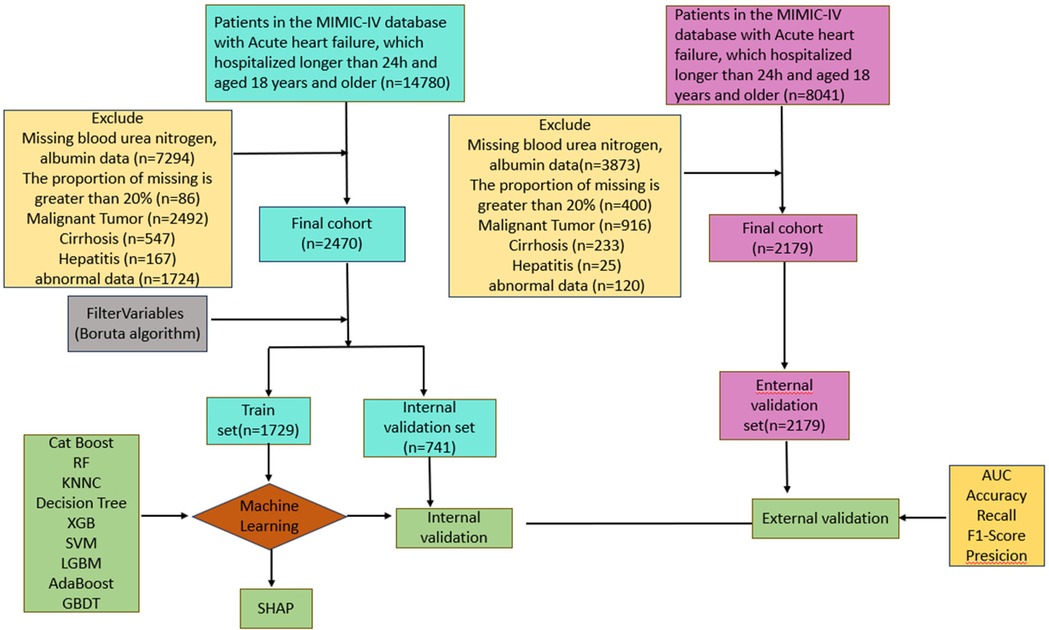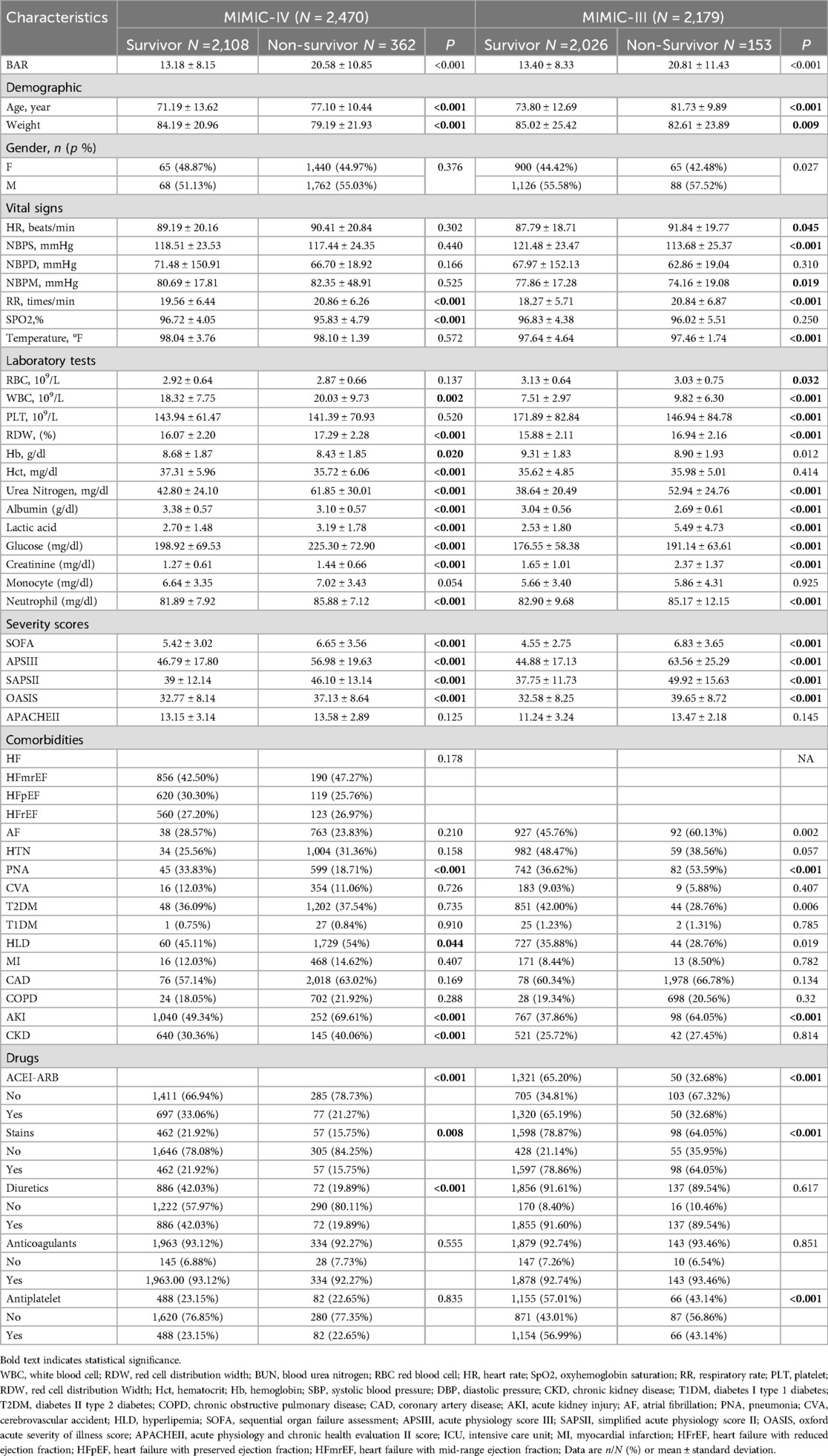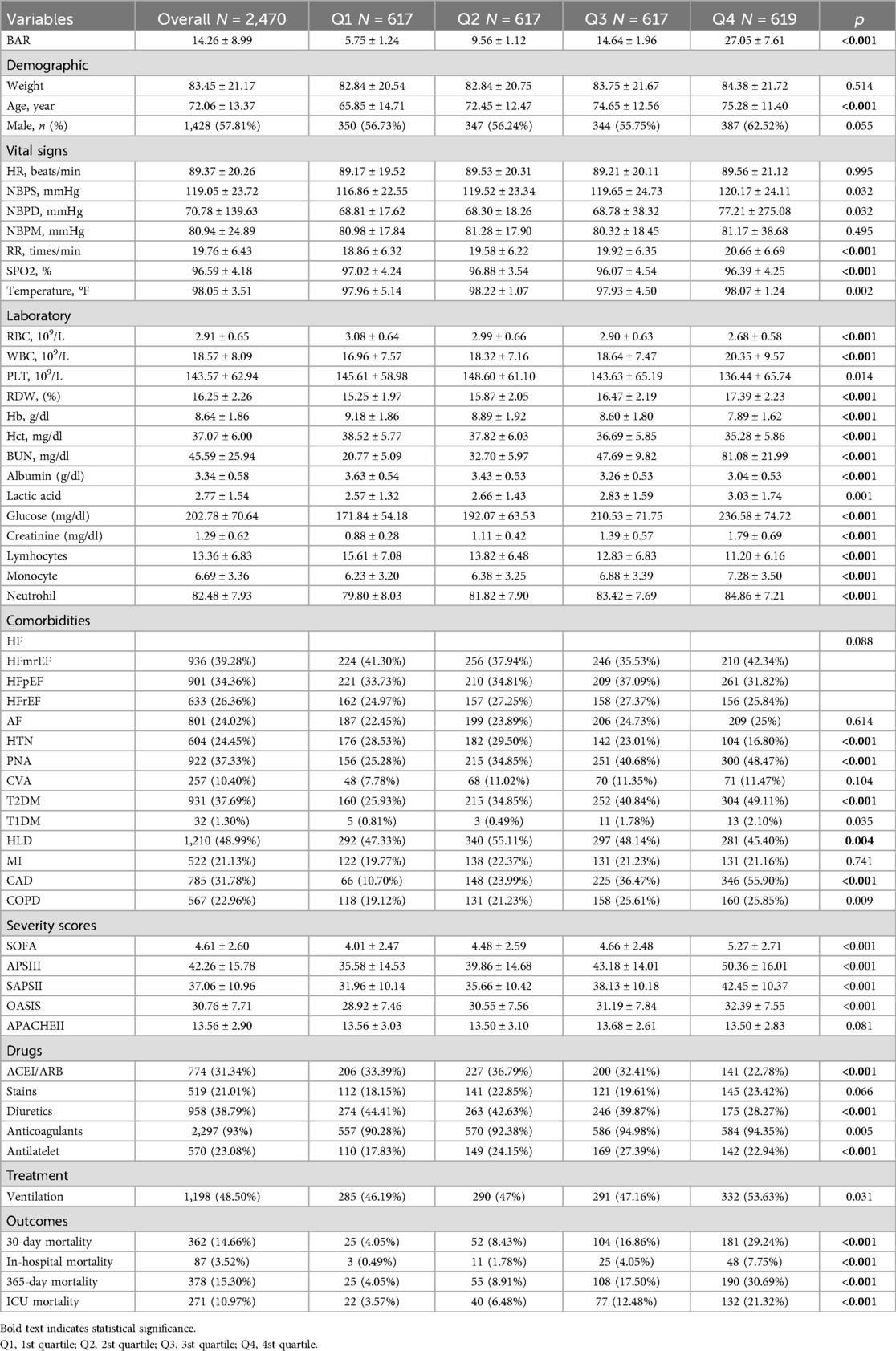- 1Department of Integrated Cardiology, China-Japan Friendship Hospital, Beijing, China
- 2Beijing University of Chinese Medicine, Beijing, China
- 3Department of Cardiovascular Medicine, Dongzhimen Hospital, Beijing, China
- 4Department of Pain Management, China-Japan Friendship Hospital, Beijing, China
- 5Department of Neurology, Hefei Hospital Affiliated to Anhui Medical University (The Second People's Hospital of Hefei), Hefei, China
Objective: The aim of this study was to investigate the correlation between blood urea nitrogen-albumin index (BAR) and 30-day and one-year all-cause mortality in patients with heart failure admitted to the intensive care unit (ICU).
Method: This is a retrospective cohort study with data from two non-overlapping datasets from the Medical Information Marketplace in Intensive Care (MIMIC), where MIMIC-IV was used for training and MIMIC-III for external validation. Risk ratios (HR) and 95% confidence intervals (CI) between the BAR index and all-cause mortality were assessed using Cox proportional risk regression and Kaplan–Meier curves. Restricted cubic spline regression modeling was used to assess potential nonlinear relationships between BAR indices and outcome indicators. Nine machine learning (ML) algorithms were used to build predictive models, and, in addition, the Shapley additive interpretation (SHAP) method was used to determine feature importance.
Result: This study included 2,470 critically ill heart failure patients. Multivariate Cox regression analysis revealed that the risk of all-cause mortality was significantly higher at both 30 and 365 days for patients in the highest quartile of the BAR index. Kaplan–Meier analyses indicated that the cumulative incidence of mortality increased with higher quartiles of the BAR ratio. Additionally, multivariate restricted cubic spline regression showed a nonlinear increase in death risk at 30 and 365 days with higher BAR index values. Subgroup analyses confirmed consistent effect sizes and stability across groups. Among the nine models, XGBoost performs the best, with an AUC value of 0.894 [95% confidence interval (CI): 0.85–0.93] in the internal validation dataset and 0.924 [95% confidence interval (CI): 0.88–0.96]. The model demonstrated the best predictive performance in terms of discrimination and clinical application.
Conclusion: We found that higher BAR levels were significantly associated with a higher risk of 30- and 365-day all-cause mortality in critically ill patients with heart failure.
Background
Cardiovascular disease has been the number one threat to global health over the past few decades, with approximately 20.8 million people dying from cardiovascular disease (CVD) every year up to 2023, accounting for approximately one-third of all global deaths (1). Heart failure (HF) is a clinical syndrome characterized by structural and functional damage to the heart and is the end stage of cardiovascular disease. Heart failure has long been a major global health challenge, especially as the prevalence of HF continues to rise with the aging population and the increasing burden of comorbidities such as hypertension, diabetes, and obesity, which not only severely reduces the quality of life of patients but also imposes a huge economic burden worldwide. Patients with heart failure often have a poor prognosis, with a five-year survival rate similar to that of malignant tumors, and it is important to actively develop predictive models for patients with heart failure to improve their prognosis.
HF is the end stage of many cardiovascular diseases, and the reduction of effective circulating blood volume and insufficient organ perfusion are important pathophysiologic mechanisms of heart failure (2). The BAR index introduced by blood urea nitrogen and albumin is a valuable biomarker discovered in recent years. Although BUN is less sensitive to renal insufficiency than serum creatinine, studies are confirming that increased BUN is associated with poor prognosis in patients with heart failure (3). The kidneys have a close relationship with the heart, and in patients with chronic heart failure, the compensatory effects of the kidneys may keep BUN low, but with heart failure loss of compensation, there is insufficient effective circulating blood volume, which leads to the secretion of a variety of neurohormones, resulting in a further reduction in renal perfusion when high levels of BUN may herald more severe heart failure. Reduced levels of albumin (ALB), an abundant soluble protein component of the circulatory system, are thought to be primarily associated with cachexia, renal insufficiency, hepatic dysfunction, and inflammation. Previous studies have shown that hypoalbuminemia is an independent predictor of poor prognosis in heart failure (4). Metabolic imbalance, inflammatory response, oxidative stress, and endothelial dysfunction are important features of heart failure, and BAR, as a combination of these two hematological indices, reflects the multiple pathophysiological processes of cardiovascular disease. Therefore, active research on the BAR index and the outcome and prognosis of heart failure is necessary to help provide better insights into the clinical management of cardiovascular disease.
Previous studies have shown that higher BAR indices are associated with an increased risk of adverse outcomes in patients with myocardial infarction (5), acute coronary syndromes (6), and after cardiac surgery. However, studies on the association between BAR index and critically ill patients with heart failure are lacking. This study investigated the correlation between the BAR index and all-cause mortality in heart failure patients admitted to the intensive care unit (ICU). The results of the study may help to explore new strategies for early identification and improvement of prognosis in critically ill patients with heart failure and provide important new insights into the function of BAR in predicting patient prognosis.
Method
Data source
The data used to construct the model came from the Medical Information Mart for Intensive Care IV (MIMIC-IV, version: v2.2) (7) which contains clinical information on 431,231 hospital admissions for 299,712 patients admitted to Beth Israel Deaconess Medical Center from 2008 to 2020. We also performed external validation using a subset of the MIMIC-III database (8), which included 26,836 admissions for 23,692 patients between 2001 and 2008, and there was no overlap with patients with MIMIC-IV. The MIMIC-IV database details information on patient demographics, laboratory tests, medications, vital signs, surgeries, disease diagnoses, and follow-up survival status. In order to protect patient privacy, all personal information is de-identified and a random code is used instead of patient identification, so we do not require the patient's informed consent and ethical approval. To access the database, author Yi Tang completed the Collaborative Institutional Training Initiative (CITI) course and passed the Conflict of Interest and Data or Sample Study Only exams (ID: 13870584).
Inclusion and exclusion criteria
The study included patients with heart failure who were hospitalized for the first time and admitted to the ICU for the first time.
The inclusion criteria were as follows:
(1) Age ≥18 years.
(2) Meeting the diagnostic criteria for heart failure. In this study, heart failure and other comorbidities were diagnosed using the International Classification of Diseases, Ninth Revision (ICD-9) and Tenth Revision (ICD-10) codes (I5083, I5082, I5084, I5089,I509,40201,40291,40491,40492, 4280,4281,42820, 42821,42822,42823, 42830,42831,42832,42833, 42840,42841, 42842, 42843,4289, I5020, I5021, I5022, I5023, I5030, I5031, I5032, I5033, I5040, I5041, I5042, I5043, I50810, I50811, I50812, I50813, I50814).
The exclusion criteria were as follows:
(1) Patients with ICU hospitalization time less than 24 h.
(2) Lack of blood urea nitrogen and serum albumin in laboratory tests.
(3) For patients with multiple ICU admissions, only data from the first hospitalization were included.
(4) Patients with direct or indirect causes of abnormal release of blood urea nitrogen and albumin, including hepatitis, cirrhosis, and malignancy, were excluded from the study.
Data collection and definitions
Structured Query Language (SQL) in PostgreSQL was used to extract data from both databases for patients admitted to the ICU within the previous 24 h. The variables extracted for this study were (1) demographics: age, gender, weight; (2) comorbidities: acute myocardial infarction (AMI), hypertension (HTN), atrial fibrillation (AF), coronary heart disease (IHD), diabetes mellitus (DM), chronic obstructive pulmonary disease (COPD), stroke (CVA), pneumonia (PNA), acute kidney injury (AKI), chronic kidney disease (CKD), hyperlipidemia (HLD). (3) Vital signs: systolic blood pressure (SBP), diastolic blood pressure (DBP), mean blood pressure (MBP), heart rate (HR), respiratory rate (RR), oxygen saturation (SPO2), temperature; (4) Drugs: angiotensin-converting enzyme inhibitors/angiotensin receptor blockers (ACEI/ARB), diuretics, statins, antiplatelet agents, Anticoagulants; (5) Laboratory data: red blood cells (RBC), red blood cell distribution width (RDW), hematocrit (Hct), hemoglobin (Hb), platelets (PLT), white blood cells (WBC), glucose, blood urea nitrogen (BUN), creatinine, neutrophil, lymphocytes, monocytes, lactic acid (Lac), blood urea nitrogen (BUN), albumin (ALB); (6): scoring data: Oxford Acute Severity of Illness Score (OASIS), Simplified Acute Physiology Score (SAPSII), Sequential Organ Failure Assessment (SOFA), Acute Physiology and Chronic Health Score (APSIII), Acute Physiology and Chronic Health Score (APACHEII). (7): Baseline treatment: Invasive mechanical ventilation (IMV).
All laboratory indices extracted from the MIMIC-IV (2.2) database were taken from each measurement made after the patient's admission to the ICU, and the worst of these values was taken. The blood urea nitrogen-albumin ratio (BAR) was defined as an index calculated using the following formula: BAR = blood urea nitrogen/albumin. Missing values for laboratory indicators are common in the MIMIC-IV database. To minimize bias due to sample exclusion, we calculated the percentage of missing values for each continuous variable. To avoid bias, variables with missing values exceeding 20% were excluded. Variables with missing values between 5% and 10% were treated using multiple imputations, and variables with missing values less than 5% were treated using mean imputation. Outliers were filtered using the BoxPlot method.
Outcome measures
The primary study endpoints were 30 and 365-day mortality after ICU admission, and the secondary study endpoints were in-hospital and ICU all-cause mortality.
Statistical analysis
Categorical variables were assessed using Fisher's exact probability method or chi-square test and expressed as counts (percentages). Continuous variables were expressed as interquartile ranges, and medians were tested using the Wilcoxon rank sum test. Multicollinearity was checked using Variance Inflation Factor (VIF), and variables with VIF above 5 were deleted (9, 10). Patients were categorized into 4 groups based on the quartiles of the BAR index, with the lowest quartile as the reference group. Kaplan–Meier survival analysis was used to assess the incidence of 30-day and one-year mortality events between groups based on different BAR levels, followed by a log-rank test to assess the significance of the differences between groups and a log Rank test to compare the two curves. Restricted cubic spline (RCS) curves were used to explore potential nonlinear relationships between the BAR Index and 30-day and one-year mortality rates and to create a threshold effects model to identify inflection points in the BAR Index. Univariate and multivariate Cox regression analyses were conducted using Boruta's algorithm to characterize the screened variables and to test for trends, adjusting for several confounding variables. (Model 1: includes only the BAR index without any adjustment; Model 2 is adjusted for demographic variables such as age, gender, weight, etc.; Model 3: Combines important characteristic variables based on clinical expertise and screening from Boruta and Random Forest algorithms, including age, weight, PNA, AKI, PLT, RDW, neutrophils, HCT, blood urea nitrogen, lactate, lymphocytes, monocytes, diuretics, APSIII, SAPAII, and OASIS. Finally, we also performed subgroup analyses including sex, age, comorbidities [acute kidney injury (AKI), coronary heart disease (CKD), type 2 diabetes mellitus, diuretics, and mechanical ventilation], and assessed the P of the interaction using the log-likelihood ratio test. Statistical analyses for this study were performed using Python (version 3.9.12), SPSS (version 25.0), and DecisionLnc1.0 (11) software.
The establishment and validation of predictive models
We internally validated the MIMIC-IV database by dividing the training and test sets in 7:3. Subsequently, we validated the model externally using MIMIC-III. By combining internal and external validation, we were able to comprehensively assess the performance and generalization ability of the constructed models. In this study, nine machine learning algorithms, namely Extreme Gradient Boosting (XGBoost), Support Vector Machine (SVM), Adaptive Boosting (Adaboost), Light Gradient Boosting Machine (LGB), K-Nearest Neighbor Classifier (KNNC), Decision Tree (DT), Random Forest (RF), Gradient Boosting Based (CatBoost), and Gradient Boosting Tree (GBDT), are used to construct the prediction models. In order to optimize the overall performance of the model, we implemented feature selection during the modeling process to reduce the complexity of the model and enhance generalization.
The essence of the algorithm is based on two concepts: “shadow features” and “binomial distribution”. Boruta generates a set of copies of features, called shaded features, from the original dataset. Elements were considered significant and retained if their Z-scores exceeded the maximum possible Z-score for the shaded elements, indicating that they had the largest matching effect (ratio or risk ratio) among the set of biomarkers; otherwise, they were excluded (12). The maximum area under the curve (AUC) of the subject's work characteristics (ROC) was selected as the optimal model during the parameter tuning process. The performance of the predictive model was evaluated by AUC, sensitivity, specificity, recall, F1 score, accuracy and recall of the ROC curve. In addition, decision curve analysis (DCA) and calibration curves were plotted to assess the net clinical benefit. The interpretability of the final predictive model was explored using the Shapley summation and interpretation (SHAP) method (13).
Results
Baseline demographic and clinical characteristics
As shown in Figure 1, After screening, the study included 2470 patients from the MIMIC-IV database (mean age 72.06 years, 57.81% male) and 2179 patients from the MIMIC-III database (mean age 74.36 years, 45.30% male). Table 1 summarizes the comparison of baseline characteristics, vital signs, severity scores, comorbidities, medications used, and laboratory indices between nonsurvivors and survivors at 30 days. The comparison between the survival (2108,85.3%) and non-survival (362, 14.7%) groups showed that, in the non-survivor group, age, weight, RR, SPO2, WBC, RDW, Hb, Hct, Albumin, Urea Nitrogen, Lactic acid, Glucose, Creatinine, Neutrophil, SOFA, SAPS II, OASIS, APSIII, APACHEII, PNA, HLD, AKI, CKD, ACEI/ARB, statins, diuretics compared to survivors significantly. In addition, we divided heart failure into heart failure with reduced ejection fraction (HFrEF), heart failure with preserved ejection fraction (HFpEF), and heart failure with intermediate ejection fraction (HFmrEF) according to the ejection fraction LVEF, and we found that HFmrEF had the highest number of people, and although the proportion of HFmrEF was slightly higher in the death group than in the survival group, this difference was not statistically significant (p = 0.178). Among patients receiving medications, we found that mortality was lower in patients using ACEI/ARBs, statins, and diuretics, and the use of these medications was significantly higher in the survivor group than in the fatal group, suggesting that these medications may be associated with lower mortality. However, the relationship between anticoagulants and antiplatelet agents and mortality was not significant, and further studies are needed to confirm their effects.
In Table 2, the hospital, ICU, 30-day, and 365-day mortality rates of the patients were 3.52%, 10.97%, 14.66%, and 15.3%, respectively. Patients were categorized into 4 groups based on the quartiles of the BAR index: quartile 1 (1.33 ≤ BAR < 6.58), quartile 2 (6.58 ≤ BAR < 9.39), and quartile 3 (9.39 ≤ BAR ≤ 13.94) quartile 3 (13.94 ≤ BAR ≤ 59.41), with the first 3 groups consisting of 617 individuals and the fourth group consisting of 619 individuals. Patients in quartile 4 exhibited higher weight, age, heart rate, blood pressure, respiratory rate, neutrophil count, white blood cell count, blood urea nitrogen, glucose, monocyte count, creatinine, lactate, SOFA score, mechanical ventilation, and proportion of statin use, as well as lower levels of albumin, erythrocytes, platelet count, hemoglobin, hematocrit, and SPO2.
Clinical outcomes
To investigate the independent effect of the BAR index on mortality, three Cox regression models were applied Table 3. Supplementary Table S1 shows the variance inflation factors, indicating that there is no multicollinearity between the variables. After adjusting for age, sex, and weight (Model 2), the HRs and 95% CIs for 30-day all-cause mortality for the BAR index categories (Q1, Q2, Q3, and Q4) were 1 (reference), 1.92 (1.18, 3.098), 3.92 (2.52–6.10), and 7.19 (0.98–0.99). Subsequent adjustments for age, body weight, PNA, PLT, RDW, neutrophils, hematocrit, blood urea nitrogen, lactate, lymphocytes, monocytes, diuretics, APSIII, SAPAII, and OASIS (Model 3) resulted in the following risk ratios for 30-day all-cause mortality: respectively:1.00 (reference), 1.52 (0.94–2.47), 2.28 (1.41–4.54) and 2.54 (1.42–4.54). In Model 2, the risk ratios for 365-day all-cause mortality were 1.00 (reference), 2.02 (95% CI: 1.26–3.26), 4.09 (95% CI: 2.64–6.35), and 7.49 (95% CI: 4.91–11.44), respectively. In model 3, the HRs were 1.00 (reference), 1.63 (95% CI: 1.01–2.64), 2.46 (95% CI: 1.53–3.95) and 2.75 (95% CI: 1.55–4.89). The results of the study showed that patients with a BAR index of 9.39 or higher had a significantly higher risk of all-cause mortality at both 30 and 365 days compared to those in Q2. The Kaplan–Meier survival curves illustrate the survival differences in 30- and 365-day mortality between the 4 BAR groups (Figure 2). Patients in the highest BAR index group (Q4) had significantly lower survival at 30 and 365 days than those in the lowest BAR index group (Q1) (log-rank P < 0.05).
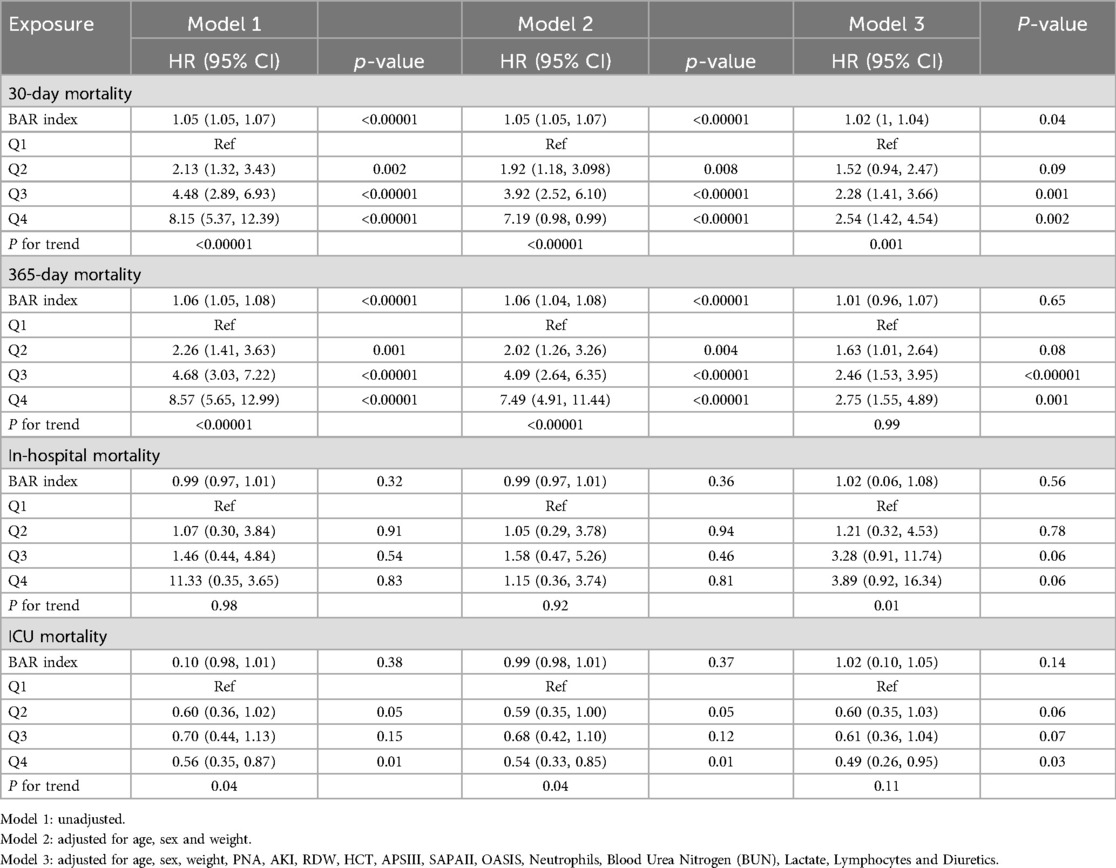
Table 3. Logistic regression analysis of 30-day, 1-year, in-hospital, and ICU mortality in heart failure patients.
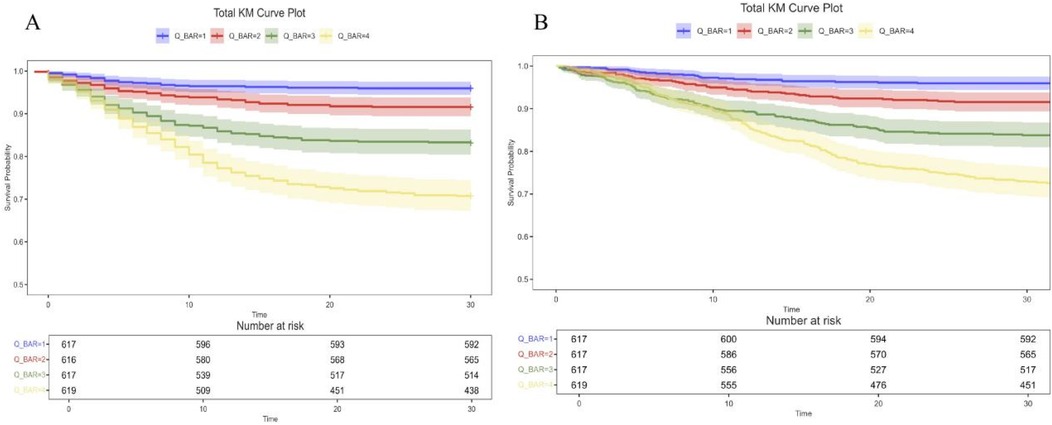
Figure 2. Kaplan–Meier survival analysis curves for all-cause mortality. Kaplan–Meier curves and cumulative incidence of 30-day (A) and 365-day (B) all-cause mortality stratified by BAR index. BAR, blood urea nitrogen to serum albumin ratio.
Restricted cubic spline
According to the multivariate RCS model, the risk of 30- and 365-day mortality was found to increase nonlinearly (p-value <0.05, non-linear p > 0.05) with increasing BAR index (Figure 3). In addition, a combination of Cox proportional risk modeling and two-stage Cox proportional risk modeling was used to investigate the nonlinear relationship between the level of BAR in heart failure patients and the aforementioned mortality rates (both P for log-likelihood ratio <0.05) (Supplementary Table S3). The inflection points for 30-day and 365-day all-cause mortality were 13.23 and 12.97, respectively. When the BAR index was below 13.23 or 12.97, the adjusted HR for 30- and 365-day mortality increased by a factor of 1 for each unit increase in the BAR level (HR 1.14; 95% CI, 1.06–1.23; HR 1.15; 95% CI, 1.06–1.24, respectively). However, when the BAR was greater than the inflection point, there was no significant association with 30- and 365-day mortality.

Figure 3. Multivariable RCS regression showed the nonlinear association between the BAR index and 30-day mortality (A) and one-year (B) mortality after full adjustment.
Subgroup analysis
The results show a subgroup analysis of 30-day all-cause mortality (Figure 4). In subgroups defined by age, sex, T2DM, AKI, CAD, diuretics, and mechanical ventilation status, Q4 consistently demonstrated a higher risk of death, with or without adjustment for covariates. The results of the subgroup analyses indicated that the BAR index was similarly associated with the 30-day risk of death in patients with critical heart failure in most subgroups of the population. The model was not significant for the interaction test of covariates with the BAR index.

Figure 4. Forest plots of stratified analyses of BAR index and all-cause mortality (30 days). With the exception of the stratified variable itself, the adjustment approach is the same as for Model 3.
Establishment and validation of the prediction model
We constructed 9 models to predict 30-day mortality in patients with heart failure, and Figure 5 shows the discriminative performance of these 9 models on the ROC curve. In addition, we evaluated and compared the performance of the models using metrics such as precision, accuracy, recall, and F1 score. Among the 9 base models, the XGBoost model demonstrated the best predictive performance with an AUC of 0.894 (95% CI: 0.85–0.93) for the XGBoost model. Following closely behind, the LGBM model showed considerable efficacy with an AUC of 0.893 (95% CI: 0.855–0.931), outperforming the remaining algorithms. The remaining models, while still showing good predictive power, are as follows in descending order of performance: CatBoost (AUC = 0.877, 95% CI: 0.842–0.914), KNNC (AUC = 0.805, 95% CI: 0.761–0.849), GBDT (AUC = 0.825, 95% CI: 0.773–0.877), AdaBoost (AUC = 0.814, 95% CI: 0.77–0.859), RF (AUC = 0.775, 95% CI: 0.729–0.823), DecisionTree (AUC = 0.689, 95% CI: 0.64–0.739), and SVM (AUC = 0.667, 95% CI: 0.602–0.731). According to the DCA curves (Figure 6B), each model showed a large net gain, indicating robust clinical validity of the models developed. Table 4 shows the detailed performance metrics of the nine models. XGBoost demonstrated the most balanced and excellent performance (precision = 0.813, recall = 0.654), LightGBM was the close alternative, and both were significantly better than the other models.
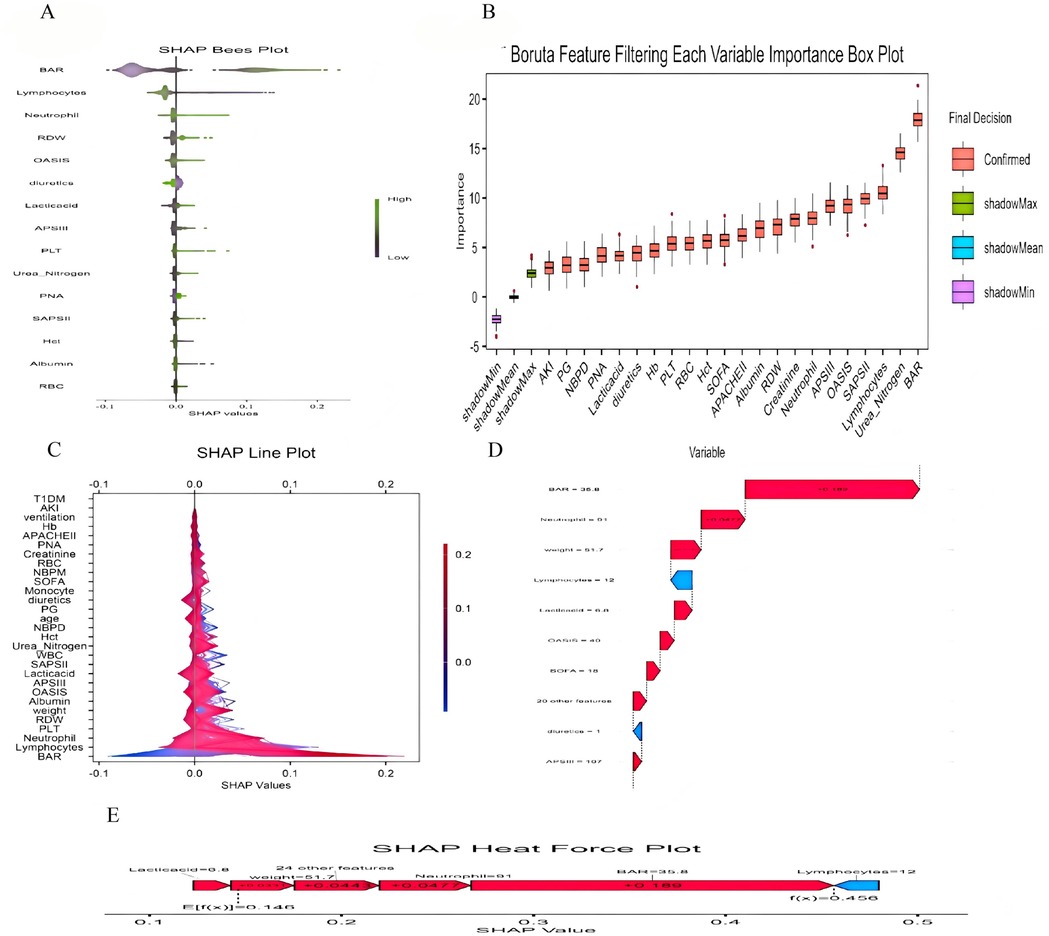
Figure 5. (A) SHAP Bees Plot.The distribution of each feature's impact on the model output. Each point represents a patient in a row. The color of the points indicates the feature value: purple represents higher values, while green represents lower values. (B) Feature Selection Using the Boruta Algorithm to Analyze the Relationship Between Various BAR Indices and 30-day Mortality. The x-axis displays the names of each variable, while the y-axis represents the Z-values of each variable. Box plots illustrate the Z-values of each variable calculated in the model, where red boxes indicate important variables, green boxes indicate tentative attributes and purple boxes indicate unimportant variables. (C) SHAP double-coordinate line graph. The SHAP plot shows the contribution of different features to the model prediction. The X-axis represents the SHAP value, and the Y-axis lists the names of each feature. The color bars indicate the magnitude of the feature values, with red representing higher feature values and blue representing lower feature values. (D) SHAP waterfall plot. The SHAP waterfall plot shows the composition of the predicted value for a single sample. The plot lists the contribution of each feature to the final predicted value. A red upward arrow indicates that the feature value increases the predicted value, while a blue downward arrow indicates that the feature value decreases the predicted value. (E) SHAP Heat Force plot.The SHAP heat force plot shows the contribution of each feature in the model prediction process. The arrows in the figure indicate the direction and magnitude of the feature's impact on the predicted value, with red arrows indicating an increase in the predicted value and blue arrows indicating a decrease in the predicted value.
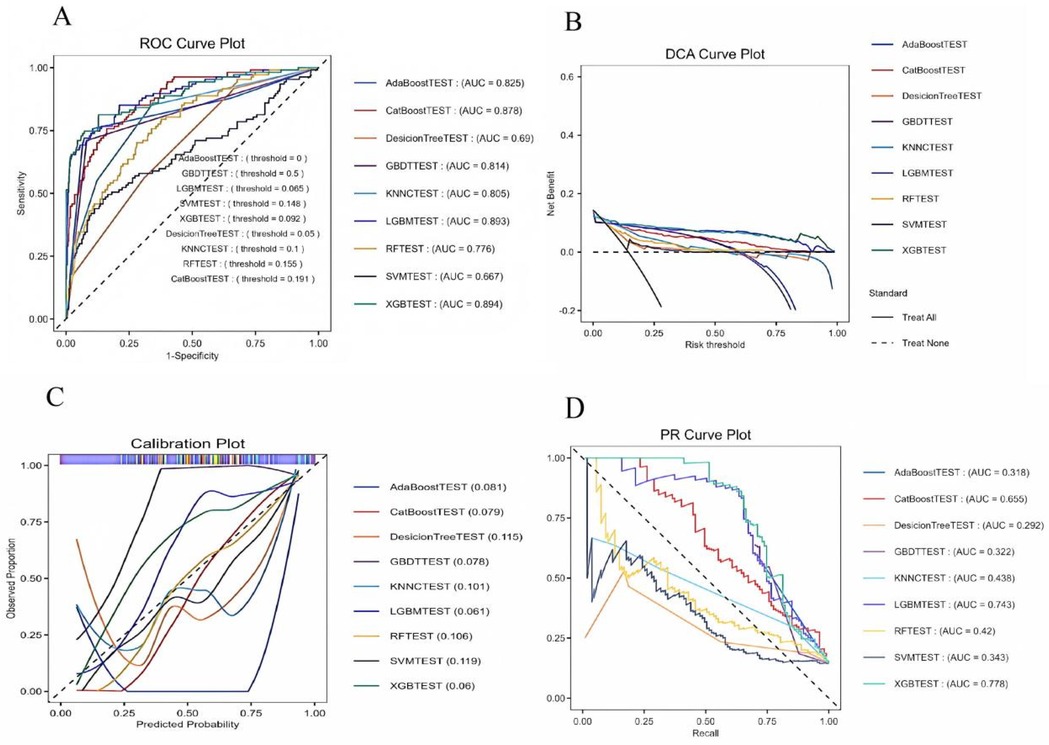
Figure 6. (A) ROC curves for the machine learning models. (B) DCA curves for the machine learning models. (C) Callibration for the machine learning models. (D) PR curves for the machine learning models. DT, decision tree; RF, random forest; XGB, extreme gradient boosting; LGB, light gradient boosting machine; KNNC, K-nearest neighbors classifier; SVM, support vector machine; Adaboost, adaptive boosting; Catboost, gradient boosting based; GBDT, gradient boosting machine; ROC, receiver operating characteristic; AUC, area under the curve.

Table 4. Predictive performances of the nine machine learning models for predicting 30day mortality.
Performance comparison of the model on the external validation set
Despite the inherent differences in baseline characteristics between the two datasets, our model exhibits strong generalization. The externally validated ROC curve yields an AUC of 0.924 (95% CI: 0.88–0.96).
Selection of characteristic variable
The SHAP method is a comprehensive interpretation method applicable to both overall and individual sample analyses for interpreting models. For the overall interpretation, SHAP implies assessing the contribution of features to the model, with the five most important features (BAR, neutrophil count, weight, uric acid, and OASIS score) listed in descending order of importance (Figure 5).
Discussion
This study is the first retrospective study to explore the association between BAR levels and all-cause mortality in critically ill patients with heart failure based on the MIMIC-IV database. Blood urea nitrogen/albumin ratio (BAR) is a newly discovered biological indicator in recent years that has the advantages of being noninvasive, easy to obtain, and widely used. Our study demonstrated a significant association between higher levels of the BAR index and increased 30-day and one-year mortality in critically ill patients with heart failure. This association held even after accounting for potential confounders, demonstrating the robustness of the findings. The study also found that patients' 30-day and one-year mortality rates were nonlinearly correlated with the BAR index.
In recent years, several clinical studies have demonstrated a correlation between elevated BUN levels and decreased ALB and poor prognosis in patients with cardiovascular disease, including acute coronary syndrome (14) and acute myocardial infarction (15). Blood urea nitrogen and albumin have long been of interest as single indicators, and the BAR index, as a combination of the two, with elevated levels that may reflect the patient's nutritional status, hepatic and renal function, as well as the inflammatory response, makes up for the lack of predictive performance of albumin or BUN alone and has the potential to be a complementary predictor for clinicians managing patients with heart failure. Lin ZB et al. (5) found that higher levels of BAR were associated with increased short-term mortality in heart failure patients undergoing intensive care. Zhao L et al. (16) conducted a cohort study with a median follow-up of 22 months and found that BAR was still associated with an increased risk of death in heart failure patients. A previous study on the association between BAR and heart failure patients only explored the relationship between BAR and in-hospital and 90-day mortality, and our study supports the previous studies; moreover, the present study reveals for the first time the relationship between the BAR index and 30-day and one-year mortality rates in heart failure patients, which is a major highlight of our study. In addition, we included patients from the U.S. Critical Care Database, which helps to provide more comprehensive results for clinical practice.
The exact biological mechanism between the BAR index and clinical outcome and prognosis in heart failure is not clear. In this study, we tried to understand the relationship between BAR and the poor prognosis of heart failure patients from the perspective of blood urea nitrogen and albumin, respectively. Blood urea nitrogen (BUN) is a major indicator of renal function, and elevated BUN levels suggest impaired renal function, blood volume deficiency, or neurohormonal activation, which may lead to poor prognosis in patients with heart failure through oxidative stress, activation of the sympathetic nervous system (SNS) and renin-angiotensin aldosterone system (RAAS), and activation of the renin-angiotensin aldosterone system (RAAS). Angiotensin aldosterone system (RAAS) leading to poor prognosis in patients with heart failure. In patients with heart failure, activation of RAAS promotes sodium retention and leads to reabsorption of blood urea nitrogen in the proximal renal tubules, whereas activation of SNS accelerates reabsorption of blood urea nitrogen in the distal renal tubules, and both mechanisms lead to elevated blood urea nitrogen (17). It is thus clear that activation of the SNS and RAAS systems is closely related to the progression of heart failure (18, 19).
Albumin is a protein synthesized by ALB from the liver and has a variety of biological functions such as antiplatelet aggregation, anticoagulation, maintenance of plasma osmolality, transport of a variety of substances, and inhibition of inflammatory responses (20). Previous studies have found a correlation between low albumin levels and poor prognosis in patients with heart failure (21). Heart failure is a disease of insufficient perfusion of relative organs due to systolic and/or diastolic dysfunction of the heart. Heart failure itself does not lead to hypoproteinemia, but patients with prolonged heart failure are often combined with infections, malnutrition, and other complications, which exacerbate the loss of albumin, and the reduction of albumin levels is closely related to inflammation, oxidative stress, endothelial dysfunction, and other pathologies, which can lead to circulating blood volume deficiency, disrupting fluid balance, and leading to heart failure decompensation.
Boruta's algorithm, a widely used method in feature selection, determines which features are most important for predicting the target variable by modeling randomness (22). The feature selection results of Boruta's algorithm in this study show that BAR significantly occupies the red region and exhibits high Z-scores in feature selection, suggesting that the BAR index may play a key role in this study, showing a significant association with the study objectives. However, we also recognize that this does not mean it is a decisive factor. This is because the Boruta algorithm may also be affected by correlations between data features. The results of multivariate COX regression analyses support the correlation between the BAR index and the risk of 30-day and 1-year mortality in patients with heart failure, which is consistent with the Boruta algorithm. In the subgroup analysis, regarding 30-day mortality, we observed no statistically significant results after stratification by variables such as age and gender. This may be due to the reduced sample size after stratification, resulting in a reduced effect size. However, the consistent direction of all results suggests the stability and reliability of the core results. Therefore, we believe that BAR can be used as a predictor of 30-day all-cause mortality in patients with heart failure.
With the rapid development of artificial intelligence in recent years, ML algorithms have been widely adopted in medical research, especially in predicting treatment outcomes and patient prognosis. We incorporate feature-significant variables into nine machine learning algorithms. The results show that the XGBoost algorithm exhibits strong performance in differentiation and calibration and shows significant net gains in clinical practice. Compared with traditional regression algorithms, the XGBoost model can automatically deal with nonlinear relationships between features, and through regularization and pruning techniques, XGBoost can reduce the risk of overfitting, thus improving the generalization ability of the model (23). In addition, the XGBoost model is robust to outliers and noisy data, and it reduces the effect of outliers by weighting the loss function, thus improving the stability of the model. This study also has some limitations. First, the present study was retrospective and could not establish a clear causal relationship between BAR index and heart failure. Nonetheless, a series of rigorous statistical methods were adopted to ensure that the results were robust and credible. Second, the BAR index is not monitored dynamically, and the BAR index obtained from taking the most severe urea nitrogen and albumin measurements may not be fully representative of the pathology in the body. Third, this is an observational study, and there may be some unmeasured or residual confounding effects that may affect the results. Fourth, when patients receive enteral or parenteral nutrition, it may affect urea nitrogen and albumin levels, potentially leading to an elevated BAR index. However, this effect may be mitigated due to the large sample size included in our study. Fifth, due to the inherent limitations of the database, the absence of some key metrics, such as NT-proBNP, may affect the comprehensiveness of our prediction model. Finally, although we used MIMIC-III as an external validation, the data were from a single center, and further large-scale, multicenter prospective studies are needed to validate the accuracy of our model.
Conclusions
Our study demonstrated that the BAR index is a predictor of 30-day mortality and one-year mortality in heart failure ICU patients. In high-risk groups, the BAR may be a valuable tool for risk assessment and subsequent intervention, and further studies are needed in the future to validate the generalizability of the ratio and the optimal cut-off value and to determine the mechanisms underlying the association between the BAR and mortality in heart failure patients.
Data availability statement
The original contributions presented in the study are included in the article/Supplementary Material, further inquiries can be directed to the corresponding authors.
Ethics statement
The requirement of ethical approval was waived by This study adhered to the principles outlined in the Declaration of Helsinki. Furthermore, it is important to note that the MIMIC-IV database received approval from the Massachusetts Institute of Technology and the Beth Israel Deaconess Medical Center. for the studies involving humans because This study adhered to the principles outlined in the Declaration of Helsinki. Furthermore, it is important to note that the MIMIC-IV database received approval from the Massachusetts Institute of Technology and the Beth Israel Deaconess Medical Center. The copies of the datasets used in this study are available from the MIMIC database. Consequently, this research trial did not require ethical approval or the acquisition of informed consent. The studies were conducted in accordance with the local legislation and institutional requirements. Written informed consent for participation was not required from the participants or the participants' legal guardians/next of kin because The copies of the datasets used in this study are available from the MIMIC database.
Author contributions
W-TS: Data curation, Methodology, Writing – original draft, Writing – review & editing. P-FC: Conceptualization, Investigation, Methodology, Project administration, Resources, Supervision, Writing – review & editing. W-HL: Investigation, Software, Visualization, Writing – review & editing. BL: Methodology, Software, Validation, Writing – review & editing. W-JW: Methodology, Software, Validation, Writing – review & editing. X-YW: Methodology, Software, Validation, Writing – review & editing. HS: Methodology, Software, Visualization, Writing – review & editing. YT: Resources, Writing – original draft. T-lL: Conceptualization, Funding acquisition, Investigation, Methodology, Project administration, Resources, Supervision, Writing – review & editing.
Funding
The author(s) declare that financial support was received for the research and/or publication of this article. National High Level Hospital Clinical Research Funding-2023-NHLHCRF-BQ-21.
Acknowledgments
We thank all the administrators who collected, organized and maintained the MIMIC database.
Conflict of interest
The authors declare that the research was conducted in the absence of any commercial or financial relationships that could be construed as a potential conflict of interest.
Generative AI statement
The author(s) declare that no Generative AI was used in the creation of this manuscript.
Any alternative text (alt text) provided alongside figures in this article has been generated by Frontiers with the support of artificial intelligence and reasonable efforts have been made to ensure accuracy, including review by the authors wherever possible. If you identify any issues, please contact us.
Publisher's note
All claims expressed in this article are solely those of the authors and do not necessarily represent those of their affiliated organizations, or those of the publisher, the editors and the reviewers. Any product that may be evaluated in this article, or claim that may be made by its manufacturer, is not guaranteed or endorsed by the publisher.
Supplementary material
The Supplementary Material for this article can be found online at: https://www.frontiersin.org/articles/10.3389/fcvm.2025.1600640/full#supplementary-material
Abbreviations
MIMIC-IV, medical information mart for intensive care IV;; BAR index, blood urea nitrogen to albumin ratio index; ICU, intensive care unit; ICD-10, international classification of diseases, tenth revision; ICD-9, based on the international classification of diseases, ninth revision; SQL, structured query language; SD, standard deviation; IQR, interquartile range; OR, odds ratios; CI, confidence intervals; CKD, chronic kidney disease; CAD, coronary artery disease; CVD, cardiovascular disease; AKI, acute kidney injury; COPD, chronic obstructive pulmonary disease; HLD, hyperlipidemia; HF, heart failure; AF, atrial fibrillation; HTN, hypertension; MI, myocardial Infarction; PNA, pneumonia; CVA, cerebrovascular accident; RDW, red blood cell width of distribution; PLT, platelet; Hb, hemoglobin; HCT, hematocrit; ML, machine learning; WBC, white blood cell; RBC, red blood cell; BUN, blood urea nitrogen; SBP, systolic blood pressure; DBP, diastolic blood pressure; MBP, mean blood pressure; HR, heart rate; SpO2, oxyhemoglobin saturation; RCS, restricted cubic spline; RF, random forest; DT, decision tree; KNNC, K-nearest neighbors classifier; XGB, extreme gradient boosting; LGB, light gradient boosting machine; SHAP, Shapley additive explanation (SHAP); SOFA, sequential organ failure estimate; APS III, acute physiology score III; SAPS II, simplified acute physiology score II; OASIS, Oxford acute severity of illness score; AUC, area under the receiver operating characteristic; DCA, decision curve analysis; ROC, receiver operating characteristic; APACHEII, acute physiology and chronic health evaluation II; ACEI/ARB, angiotensin-converting enzyme inhibitor/angiotonin receptor blocker.
References
1. Mensah GA, Fuster V, Roth GA. A heart-healthy and stroke-free world: using data to inform global action. J Am Coll Cardiol. (2023) 82(25):2343–9. doi: 10.1016/j.jacc.2023.11.003
2. Ho KL, Karwi QG, Connolly D, Pherwani S, Ketema EB, Ussher JR, et al. Metabolic, structural and biochemical changes in diabetes and the development of heart failure. Diabetologia. (2022) 65(3):411–23. doi: 10.1007/s00125-021-05637-7
3. Khoury J, Bahouth F, Stabholz Y, Elias A, Mashiach T, Aronson D, et al. Blood urea nitrogen variation upon admission and at discharge in patients with heart failure. ESC Heart Fail. (2019) 6(4):809–16. doi: 10.1002/ehf2.12471
4. Prenner SB, Pillutla R, Yenigalla S, Gaddam S, Lee J, Obeid MJ, et al. Serum albumin is a marker of myocardial fibrosis, adverse pulsatile aortic hemodynamics, and prognosis in heart failure with preserved ejection fraction. J Am Heart Assoc. (2020) 9(3):e014716. doi: 10.1161/JAHA.119.014716
5. Balcik M, Satar S, Gulen M, Acehan S, Sevdimbas S, Acele A, et al. BUN/Albumin ratio predicts short-term mortality better than SYNTAX score in ST-elevation myocardial infarction patients. J Cardiovasc Med (Hagerstown). (2023) 24(6):326–33. doi: 10.2459/JCM.0000000000001473
6. Sevdimbas S, Satar S, Gulen M, Acehan S, Acele A, Koksaldi Sahin G, et al. Blood urea nitrogen/albumin ratio on admission predicts mortality in patients with non ST segment elevation myocardial infarction. Scand J Clin Lab Invest. (2022) 82(6):454–60. doi: 10.1080/00365513.2022.2122075
7. Johnson AEW, Bulgarelli L, Shen L, Gayles A, Shammout A, Horng S, et al. MIMIC-IV, a freely accessible electronic health record dataset. Sci Data. (2023) 10(1):1. doi: 10.1038/s41597-022-01899-x
8. Johnson AE, Pollard TJ, Shen L, Lehman LW, Feng M, Ghassemi M, et al. MIMIC-III, a freely accessible critical care database. Sci Data. (2016) 3:160035. doi: 10.1038/sdata.2016.35
9. González Ariza A, Navas González FJ, León Jurado JM, Arando Arbulu A, Delgado Bermejo JV, Camacho Vallejo ME. Data mining as a tool to infer chicken carcass and meat cut quality from autochthonous genotypes. Animals (Basel). (2022) 12(19):2702. doi: 10.3390/ani12192702
10. Salgado Pardo JI, Navas González FJ, González Ariza A, León Jurado JM, Galán Luque I, Delgado Bermejo JV, et al. Study of meat and carcass quality-related traits in Turkey populations through discriminant canonical analysis. Foods. (2023) 12(20):3828. doi: 10.3390/foods12203828
11. Decisionlinnc Core Team. Decisionlinnc.1.0. (2023). Available online at: https://www.statsape.com/
12. Degenhardt F, Seifert S, Szymczak S. Evaluation of variable selection methods for random forests and omics data sets. Brief Bioinform. (2019) 20(2):492–503. doi: 10.1093/bib/bbx124
13. Lundberg SM, Erion G, Chen H, DeGrave A, Prutkin JM, Nair B, et al. From local explanations to global understanding with explainable AI for trees. Nat Mach Intell. (2020) 2(1):56–67. doi: 10.1038/s42256-019-0138-9
14. Jiang T, Gradus JL, Rosellini AJ. Supervised machine learning: a brief primer. Behav Ther. (2020) 51(5):675–87. doi: 10.1016/j.beth.2020.05.002
15. Kirtane AJ, Leder DM, Waikar SS, Chertow GM, Ray KK, Pinto DS, et al. Serum blood urea nitrogen as an independent marker of subsequent mortality among patients with acute coronary syndromes and normal to mildly reduced glomerular filtration rates. J Am Coll Cardiol. (2005) 45(11):1781–6. doi: 10.1016/j.jacc.2005.02.068
16. Lin Z, Zhao Y, Xiao L, Qi C, Chen Q, Li Y. Blood urea nitrogen to serum albumin ratio as a new prognostic indicator in critical patients with chronic heart failure. ESC Heart Fail. (2022) 9(2):1360–9. doi: 10.1002/ehf2.13825
17. Zhao L, Liu Y, Tan Z, Zhang M, Li S, Luo G, et al. The prognostic value of blood urea nitrogen to albumin ratio on patients with heart failure. Int Heart J. (2023) 64(6):1010–7. doi: 10.1536/ihj.23-383
18. Dutta A, Saha S, Bahl A, Mittal A, Basak T. A comprehensive review of acute cardio-renal syndrome: need for novel biomarkers. Front Pharmacol. (2023) 14:1152055. doi: 10.3389/fphar.2023.1152055
19. Hartupee J, Mann DL. Neurohormonal activation in heart failure with reduced ejection fraction. Nat Rev Cardiol. (2017) 14(1):30–8. doi: 10.1038/nrcardio.2016.163
20. Mascolo A, di Mauro G, Cappetta D, De Angelis A, Torella D, Urbanek K, et al. Current and future therapeutic perspective in chronic heart failure. Pharmacol Res. (2022) 175:106035. doi: 10.1016/j.phrs.2021.106035
21. Chien SC, Chen CY, Lin CF, Yeh HI. Critical appraisal of the role of serum albumin in cardiovascular disease. Biomark Res. (2017) 5:31. doi: 10.1186/s40364-017-0111-x
22. Manolis AA, Manolis TA, Melita H, Mikhailidis DP, Manolis AS. Low serum albumin: a neglected predictor in patients with cardiovascular disease. Eur J Intern Med. (2022) 102:24–39. doi: 10.1016/j.ejim.2022.05.004
Keywords: BAR index, heart failure, ICU, MIMIC-IV database, 30-day mortality
Citation: Sun W-T, Chang P-F, Liu W-H, Liu B, Wang W-J, Wang X-Y, Su H, Tang Y and Li T-l (2025) Correlation between blood urea nitrogen/albumin levels and 30-day all-cause mortality in critically Ill patients with heart failure: a retrospective cohort study and predictive model development based on machine learning. Front. Cardiovasc. Med. 12:1600640. doi: 10.3389/fcvm.2025.1600640
Received: 26 March 2025; Accepted: 18 August 2025;
Published: 5 September 2025.
Edited by:
Lin Gu, National Institute of Informatics, JapanReviewed by:
Vincenzo Santinelli, IRCCS San Donato Polyclinic, ItalyTahir Yagdi, EGE University Department of Cardivascular Surgery, Türkiye
Copyright: © 2025 Sun, Chang, Liu, Liu, Wang, Wang, Su, Tang and Li. This is an open-access article distributed under the terms of the Creative Commons Attribution License (CC BY). The use, distribution or reproduction in other forums is permitted, provided the original author(s) and the copyright owner(s) are credited and that the original publication in this journal is cited, in accordance with accepted academic practice. No use, distribution or reproduction is permitted which does not comply with these terms.
*Correspondence: Tian-li Li, MTA5OTE4ODA5MkBxcS5jb20=
†These authors share first authorship
 Wen-Ting Sun
Wen-Ting Sun Pei-Feng Chang2,3,†
Pei-Feng Chang2,3,† Wen-Hui Liu
Wen-Hui Liu Wu-Jiao Wang
Wu-Jiao Wang Tian-li Li
Tian-li Li